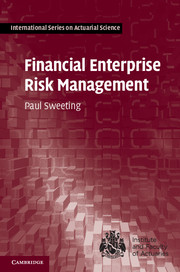Book contents
- Frontmatter
- Contents
- Preface
- 1 An introduction to enterprise risk management
- 2 Types of financial institution
- 3 Stakeholders
- 4 The internal environment
- 5 The external environment
- 6 Process overview
- 7 Definitions of risk
- 8 Risk identification
- 9 Some useful statistics
- 10 Statistical distributions
- 11 Modelling techniques
- 12 Extreme value theory
- 13 Modelling time series
- 14 Quantifying particular risks
- 15 Risk assessment
- 16 Responses to risk
- 17 Continuous considerations
- 18 Economic capital
- 19 Risk frameworks
- 20 Case studies
- References
- Index
11 - Modelling techniques
Published online by Cambridge University Press: 07 October 2011
- Frontmatter
- Contents
- Preface
- 1 An introduction to enterprise risk management
- 2 Types of financial institution
- 3 Stakeholders
- 4 The internal environment
- 5 The external environment
- 6 Process overview
- 7 Definitions of risk
- 8 Risk identification
- 9 Some useful statistics
- 10 Statistical distributions
- 11 Modelling techniques
- 12 Extreme value theory
- 13 Modelling time series
- 14 Quantifying particular risks
- 15 Risk assessment
- 16 Responses to risk
- 17 Continuous considerations
- 18 Economic capital
- 19 Risk frameworks
- 20 Case studies
- References
- Index
Summary
Introduction
One of the most common ways in which risks can be quantified is through the use of models. Models are mathematical representations of real-world processes. This does not mean that all models should attempt to exactly replicate the way in which the real world works – they are, after all, only models. However, it is important that models are appropriate for the uses to which they are put, and that any limitations of models are recognised. This is particularly important if a model designed for one purpose is being considered for another. Similarly, models calibrated using data in a particular range may not be appropriate for data outside those ranges – a model designed when asset price movements are small may break down when volatility increases. Appropriateness will also differ from organisation to organisation. A model appropriate for analysing the large annuity book of one insurer may give unrealistic answers if used with the smaller annuity book of a competitor.
Even if a model is deemed appropriate for the use to which it is put, uncertainty still remains. The structure of most models is a matter of preference, and the parameters chosen will depend on the exact period and type of data used. This uncertainty should be reflected by considering a range of structures and parameters, and analysing the extent to which changes affect the outputs of the model. This gives a guide as to how robust a model is. In particular, the structure of a model that gives significantly different outputs when calibrated using different data ranges should be reconsidered.
- Type
- Chapter
- Information
- Financial Enterprise Risk Management , pp. 221 - 271Publisher: Cambridge University PressPrint publication year: 2011

